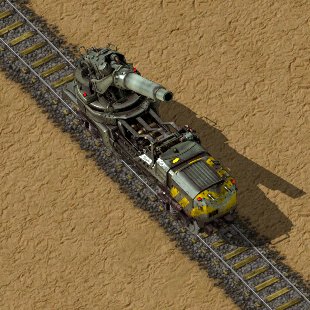Artillery wagon
| Artillery wagon |
|
Recipe |
|
| + + + + + → | |
|
Total raw |
|
| + + + + + |
|
Recipe |
|
| + + + + + → | |
|
Total raw |
|
| + + + + + |
|
Map icon |
|
|
Health |
600 |
|
Resistances |
Acid: 3/20% |
|
Stack size |
5 |
|
Range |
Minimum: 32 |
|
Shooting speed |
0.3/s |
|
Ammunition |
|
|
Dimensions |
2×6 |
|
Mining time |
0.5 |
|
Weight |
4000 |
|
Prototype type |
|
|
Internal name |
artillery-wagon |
|
Required technologies |
|
|
Boosting technologies |
|
|
Produced by |
|
The artillery wagon is an end-game wagon added in game version 0.16 mounting a rail cannon that can be added to a train. It fires artillery shells, relatively slow-moving projectiles that explore chunks of terrain they travel across. The wagon gun has both automatic and manual (even longer-ranged) firing modes. Projectiles have sufficient damage to destroy spawners and any type of worm with a single hit, and have a modest area of effect. Infinitely-stacking research upgrades are available for range and firing speed, but not damage.
The artillery turret is essentially the same weapon, but deployed as a static structure like other turrets.
Mechanics
Artillery wagons have a massive range, outranging fixed fortifications by a factor of 10 or more. In automatic mode, when the train isn't moving, the artillery wagon will automatically scan for enemy structures (spawners and worms) and shoot at them. Automatic mode cannot target mobile units (biters and spitters); shells do, however, damage mobile units in the vicinity of impact normally.
In manual mode, a special item is used to point-and-click anywhere in the world, map, or zoomed-in map; each click corresponds to one shell delivered to that location, so long as any working artillery turrets and / or wagons are in range. Targeting remotes show the number of fire-ready (loaded and, for wagons, stationary) artillery pieces in range of cursor position when held. Manual fire can be ordered on unexplored areas; shells will explore all chunks they travel across (but no surrounding chunks).
Range in automatic mode is 224 tiles (7 chunks); in manual mode, 560 tiles (17.5 chunks). Infinite research is available to increase range, at +30% of base range per level, applied to both automatic and manual range.
Limitations
Aside from the considerable expense of research and assembly for both wagons and shells, there are certain considerations that make these wagons unwise as a full replacement for traditional base defenses, despite their phenomenal range and the advantage of mobility.
Artillery shelling will antagonize enemy mobile units in the vicinity of the impact into rushing the wagon's location at time of firing, regardless of their normal "aggro radius". Artillery wagons are relatively slow-firing, although infinite research is available to improve firing speed, at +100% per level, affecting both wagons and stationary turrets and applying to both automatic and manual mode. They also cannot target mobile units in automatic mode. Importantly, artillery has a minimum range as well, which is 32 tiles.
Together, these limitations mean that an artillery wagon needs to be defended, or else moved around rapidly, in the latter case decreasing its value as base defense. For defense, any conventional approach such as walls, gun, laser, and / or flamethrower turrets, or the personal intervention of the player will do. However, players should keep in mind that extensive shelling of large biter-infested areas will produce massive attack waves centered on the position of the artillery piece at time of firing, and should plan close-range defenses accordingly.
Logistic considerations are also important, as artillery shells have a stack size of 1, meaning any-size container can only hold a modest supply and an inserter will only ever move a single shell at a time. Players may wish to consider assembling near artillery wagon stops if practical. The wagon itself can hold a supply of 100 shells (while artillery turrets only hold 15), providing a portable magazine of some size that can be towed around with the weapon without external storage.
Train Properties
The artillery wagon can fire while stopped at a train stop, but not when stopped at a red signal or when moving. When a train with an artillery wagon is stopped at a train stop, aiming and shooting counts as activity for the purposes of "X seconds of inactivity" departure conditions in the train's schedule.
Artillery wagons weigh as much as 4 regular wagons (or 2 locomotives) for the purposes of train acceleration calculations. Fortunately, the new nuclear fuel also introduced in version 0.16 provides a massive 250% boost to acceleration (compared to 180% for rocket fuel, the next best type), making it an attractive fuel for artillery trains.
Trivia
Large rail-transported cannon were built in the late 19th and early 20th century, up until and including World War II. The larger models were heavy and very slow firing and took many hours to set up, but had a greater range and power per shot than any other weapon in existence at the time (considerably greater than battleship-size naval guns, for example). The advent of rocketry, as well as large bomber planes capable of deploying multi-ton bombs, eventually made these guns obsolete.
- Perhaps the best-known examples were the Dicke Bertha (Big Bertha, literally "Fat Bertha") and the Schwerer Gustav (Heavy Gustav), the largest gun ever fired.
History
- 0.16.0:
- Introduced
